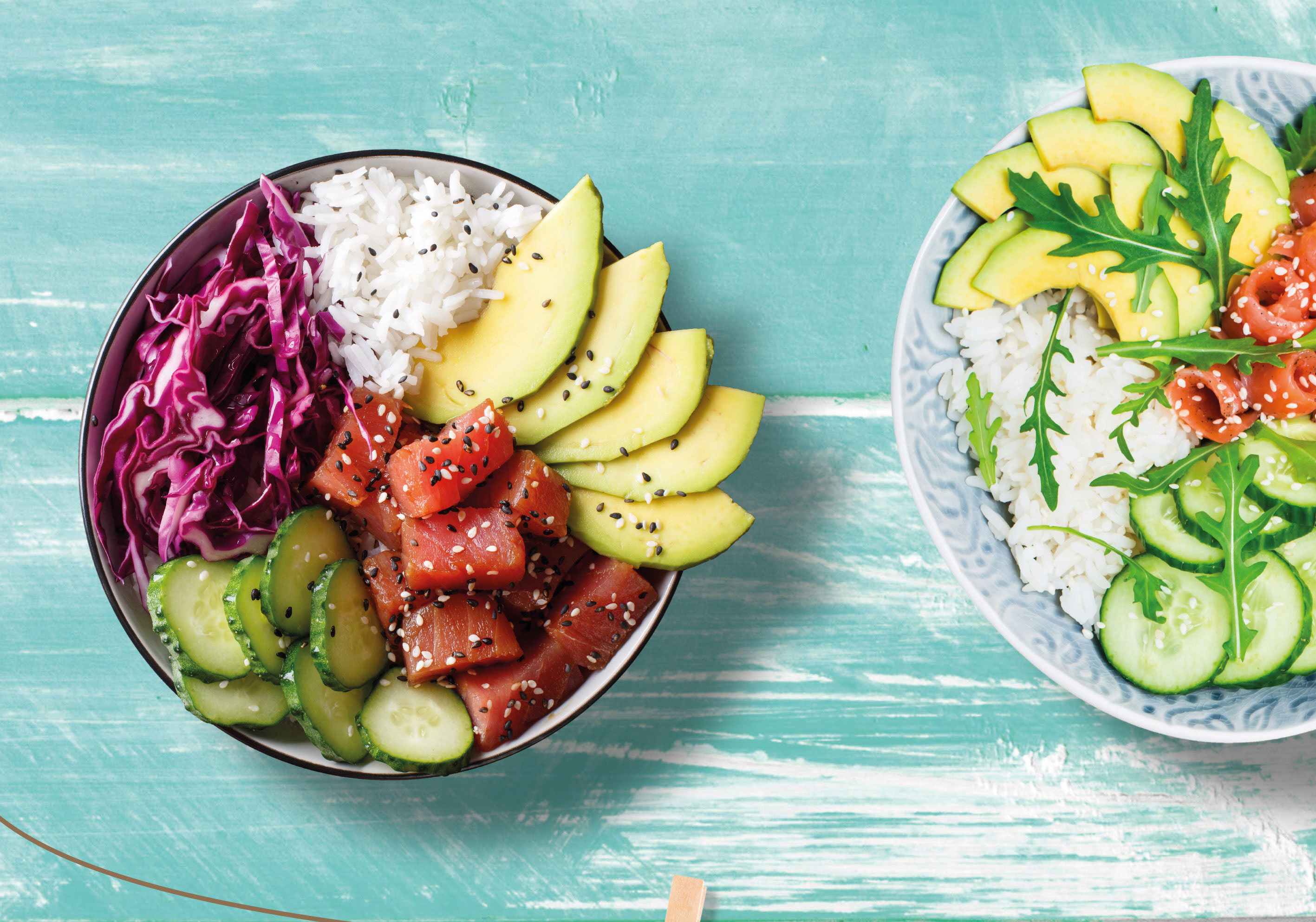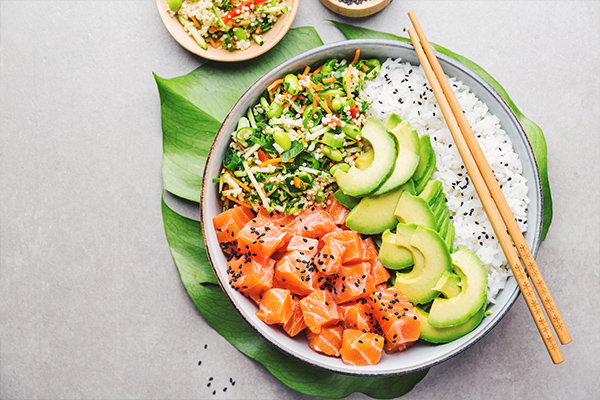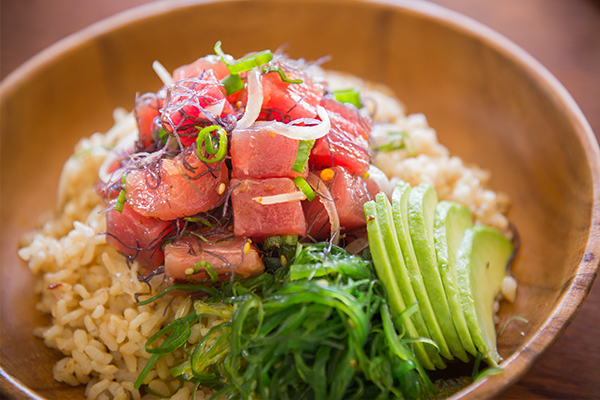Poké bowl, the healthiest Hawaiian recipe
This recipe of Hawaiian origin is tasty and healthy in equal parts, is increasingly found restaurant menus, social networks and cookbooks. If you want to learn how to prepare your own poké at home, read on...
on today's menu
Share

Foodie trends are increasingly present in our lives. They fill our social networks and 'captivate' us in such a way that it is impossible to resist. These fashionable recipes usually last a few months, but the '#poké' is here to stay, as shown by the more than a million and a half publications present on Instagram under this hashtag, or the 126 million Google results that are shown with this term.
What is the poké bowl?
Poké (pronounced "POH-keh") is a dish that started off in the humblest way in Hawaii and ended up being part of its identity. Now, its fame has crossed borders and it is eaten all over the world.
Poké means "to cut transversally into pieces", in this case applied to the raw fish. This is the origin of everything, but the influence of different cultures and gastronomic trends led to the addition of rice and other ingredients, such as soy sauce or sesame oil, two ingredients from Japanese recipes.
Much of the success of this Hawaiian recipe lies in its ingredients, which offer a healthy alternative (a fish base usually accompanied by rice, seaweed, vegetables, seeds ...) to fast food, while being very easy to prepare. In addition, these are very tasty recipes with many possibilities.
It has so many versions and combinations of foods that it is normal for a person to end up finding their perfect bowl.
The rise in popularity of raw fish, the type of bowl as an aesthetic container, and the combination of superfoods, make this dish an interesting gastronomic choice, just as sushi, tartar or ceviche were in their day.
Ingredients of the poké bowl
-Base: the most traditional choice would be white sushi rice, although it can also be substituted by round rice, brown rice or black rice. Even though it is the usual ingredient, you can make poké with other types of cereals, pasta or vegetables.the most traditional choice would be white sushi rice, although it can also be substituted by round rice, brown rice or black rice. Even though it is the usual ingredient, you can make poké with other types of cereals, pasta or vegetables.
- Vegetables: These are usually used raw and seasonal, giving the recipe an extra freshness, while adding flavour, colour and a crunchy texture to the dish.
- Fish: This is usually the main ingredient. Among the most common are salmon or raw tuna, although there are also other options with octopus, for example. In this sense, it is essential that the product is fresh. Ask your fishmonger to prepare it for you (shelled, without de-gutted and de-boned and filleted very finely) and take it home ready to eat. If you don't like raw fish, you can opt for other foods such as avocado or boiled sweet potato, for example.
It is important to keep in mind that you must freeze the fish to avoid anisakiasis, and that as the poké is not marinated fish, you should only rest the mixture 5 minutes, because the essence of the dish is to preserve the raw tuna flavour.
- Dressings and seasonings: They add the 'finishing touch’ to our poké. One of the most popular is furikake (a condiment rich in umami that is usually made with seaweed and sesame seeds). These accompaniments provide flavour and texture, and are eye-catching if they contain seeds.
Recipes for the poké bowl
Poké bowl with a Chinese salad base
Salmon Poké Bowl

Ingredients
- 1/2 avocado (peeled and sliced or cubed)
- 1/2 tablespoon white sesame seeds
-1/2 teaspoon wasabi
- 1/2 k salmon loin (skinless and boneless)
- 1/2 lime (juiced)
-1 tablespoon mayonnaise
- Ginger (peeled and grated, to taste)
- 2 spring onions
- 3 tablespoons soy sauce with lime juice
- 60 g rice (white round grain)
- 60 g cucumber (unpeeled and diced)
- 60 g avocado (sliced or diced)
Instructions
1. Cut the salmon into cubes. In a bowl, stir together the soy sauce with the dash of lime juice, grated ginger and crushed sesame seeds, but save a few to decorate. Add the salmon cubes and marinate while you continue with everything else.
2. Cook the rice for the time indicated with a little salt. When the liquid is completely gone, turn off the heat and cover the saucepan for a few minutes. Then stir and let it cool. Meanwhile, clean the spring onions and leave only the green leaves. Wash.
3. Drain the salmon without leaving it too dry and mix the marinade juices with the mayonnaise, wasabi and lime juice to taste. Place the avocado, cucumber and some sesame seeds on one side of the bowl. Stir.
4. On the other side of the bowl, place the rice. In the centre, but more on the side of the avocado and cucumber, place the drained salmon so that you can see the rice, and sprinkle everything with the sauce. Decorate the top with the green of the Chinese spring onion cut into juliennes.
Tuna Poké Bowl

Ingredients
- ½ kg of tuna belly in a slice of 2-3 cm thickness
- 1 tbsp. sriracha sauce (hot chili sauce)
- 1 tablespoon mixed black and white sesame seeds
- 1 tablespoon rice vinegar or 2 tablespoons lime juice
- 2 cm ginger, peeled and grated
- 2-3 mounds of wacame seaweed, dried or frozen
- 2 spring onions (long ones)
- 2 tablespoons soy sauce
- 3 tablespoons sesame oil, toasted or natural, to taste
- 60 g rice
Instructions
1. Clean the spring onions and cut them into juliennes, separating the green part from the white part.
2. Cut the tuna into 3 cm cubes and place it in a salad bowl in which the soy sauce, the sriracha (which can be replaced by a mixture of tabasco, a little sugar and the same amount of vinegar), a spoonful of sesame oil, the white of the spring onions, the grated ginger and the vinegar have been mixed before. Stir and marinate for as long as it takes to complete the remaining instructions.
3. Soak the seaweed until it is rehydrated and soft -about 20 minutes-. Or defrost it and wash in cold water. Drain and mix them in a bowl with the two types of sesame seeds and half a spoonful of sesame oil. Let it stand.
oWhile the above stands, cook the rice and when the liquid is gone, turn off the fire and cover the saucepan. Let it stand for a few minutes, uncover and stir. Let it cool.
4. Spread the rice on one side of the bowl and the seaweed on the other. Drain the tuna from the marinade and distribute over the rice and seaweed. Mix the resulting juice with the rest of the sesame oil. Taste for salt, acidity and spiciness and correct according to taste. Pour the juice and spread the green of the spring onion over it. Serve immediately.







